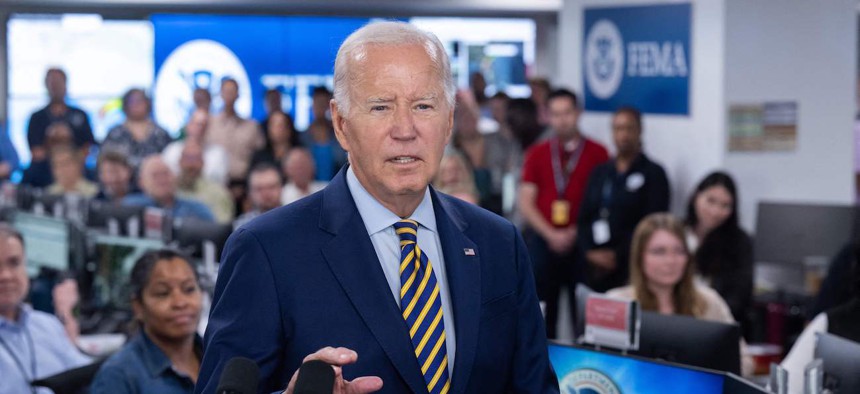
President Biden speaks at the Federal Emergency Management Agency headquarters on Aug. 31, 2023, thanking the team staffing the FEMA National Response Coordination Center throughout Hurricane Idalia and the fires in Maui, Hawaii. SAUL LOEB/AFP via Getty Images
Biden administration soliciting volunteers throughout government to deploy for disaster response
FEMA has said the assignments from other agencies could help ensure an adequate recovery effort.
The Biden administration has opened the door for volunteers throughout government to deploy to regions struck by disasters, tapping a cadre of federal employees who can supplement recovery efforts.
Federal agencies have begun making preparations to send employees to support federal recovery efforts in response to the wildfires in Hawaii and Hurricane Idalia. The Homeland Security Department, which manages the program that allows federal employees to deploy, has signed an activation memorandum, according to agency plans obtained by Government Executive.
DHS Secretary Alejandro Mayorkas recently said the Surge Capacity Force has grown to 9,000 volunteers within the department and at agencies across government as part of an initiative in which employees who have previously volunteered can deploy as disasters strike. Congress created the force in the 2006 Post-Katrina Emergency Management Reform Act and FEMA has activated it on limited occasions for hurricane response, as well as to address upticks in migrants arriving at the southern border and for COVID-19 response.
Most recently, FEMA activated the force and deployed volunteers across government last year in response to Hurricane Ian. FEMA tapped thousands of federal volunteers in 2017 when dealing with three overlapping crises following Hurricanes Harvey, Irma and Maria.
DHS has different tiers it can utilize on the surge force, including a level that only activates designated employees within the department. In this case, according to internal emails at other federal agencies, FEMA and DHS have activated “tier four,” meaning pre-selected volunteers at every agency may receive opportunities to deploy.
FEMA Administrator Deanne Criswell said this week her agency, in part due to the option to deploy surge force volunteers, would have sufficient personnel to address every disaster to which it is currently responding. The agency is taking a “layered approach,” she explained, which can also include redeploying staff currently working on less acute disasters.
“So, I'm confident right now that with these two storms that we're currently dealing with in Maui and this one—or even another one to come—that we have enough personnel to go in and support these immediate lifesaving efforts,” Criswell said.
Once activated, FEMA then has to send out specific requests to agencies that are distributed out to volunteers who can choose to deploy. Each agency must accept those requests, however, weighing them against their own needs. An employee registered for the Surge Capacity Force in the Environmental Protection Agency’s budget office, for example, told Government Executive that office had been asked to make solicitations for potential deployments, only to have management nix them. In an email, an EPA official said the office could not “handle the administrative burden of supporting the current FEMA SCF activation at this time.”
Deployed employees are still paid normally, though their work hours are reimbursed by FEMA. Volunteers are told to prepare for harsh working conditions, including, potentially, limited access to power, water and housing. Their assignments generally do not exceed 45 days and can include offering support in individual assistance, disaster survivor assistance, external affairs, IT, logistics and other areas. FEMA did not respond to requests for details on how many federal volunteers it was soliciting or in what roles they would serve.
Those who deploy will join thousands of federal employees already in the field. There are more than 1,500 federal personnel in Florida and nearly 1,000 in Maui. In addition to FEMA, the departments of Defense and Health and Human Services, the Small Business Administration and the Army Corps of Engineers, among others have sent staff to assist in the response efforts.
After being tapped for disaster and wildfire response, the influx of border crossings, the resettling of Afghan evacuees and pandemic assistance, FEMA employees sounded the alarm on their lack of down time between deployments and warned of burnout as the agency no longer experiences a true offseason. FEMA reservists have told Government Executive new hires were receiving insufficient training before deployment and some employees were working 12-hour days for a month straight. There is some optimism FEMA will soon have a better ability to retain its part-time workforce after Congress passed the Civilian Reservist Emergency Workforce Act to provide those employees who leave their day jobs to address disasters with the same protections as members of the armed forces deployed to active duty.
President Biden on Thursday visited FEMA’s Washington headquarters to show his appreciation for the work the agency is doing.
“I'm here to thank all of you,” Biden said. “And I really mean this. Thank you, thank you, thank you. You are making an incredible contribution.”
The White House has asked Congress for $12 billion in emergency funding to replenish the Disaster Relief Fund and on Friday sent another request for an additional $4 billion. An Office of Management and Budget spokesperson pointed to the fires in Maui, hurricane in Florida and previous flooding in Vermont as necessitating the new money.
“The president has been clear that we’re going to stand with communities across the nation as they recover from disasters for as long as it takes, and the administration is committed to working with Congress to ensure funding for the DRF is sufficient for recovery needs,” the spokesperson said. “We urge Congress to take swift action on supplemental appropriations.”







